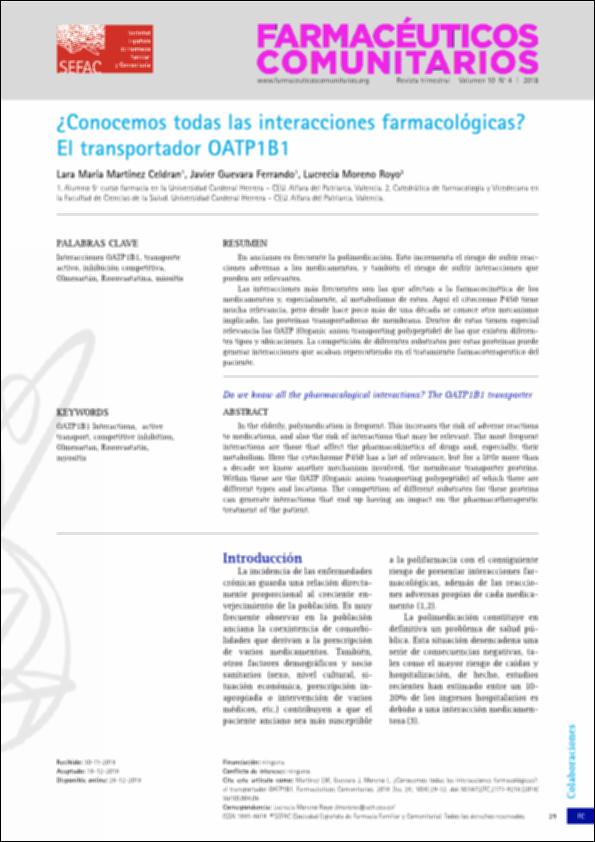Please use this identifier to cite or link to this item:
http://hdl.handle.net/10637/10226¿Conocemos todas las interacciones farmacológicas? : el transportador OATP1B1
| Title: | ¿Conocemos todas las interacciones farmacológicas? : el transportador OATP1B1 |
| Other Titles: | Do we know all the pharmacological interactions? : the OATP1B1 transporter |
| Authors : | Martínez Celdran, Lara María Guevara Ferrando, Javier Moreno Royo, Lucrecia |
| Keywords: | Drugs - Side effects.; Medicamentos - Efectos adversos.; Farmacodinamia.; Drug interactions.; Myositis.; Rosuvastatina - Efectos fisiológicos.; Olmesartan - Physiological effect.; Drugs - Physiological effect.; Medicamentos - Interacción.; Rosuvastatin - Physiological effect.; Miositis.; Olmesartán - Efectos fisiológicos. |
| Publisher: | Sociedad Española de Farmacia Comunitaria (SEFAC) |
| Citation: | Martínez Celdran, LM., Guevara Ferrando, J. y Moreno Royo, L. (2018). ¿Conocemos todas las interacciones farmacológicas? : el transportador OATP1B1 = Do we know all the pharmacological interactions? : the OATP1B1 transporter. Farmacéuticos Comunitarios, vol. 10 (diciembre), n. 4, pp. 29-32. DOI: https://doi.org/10.5672/FC.2173-9218.(2018/Vol10).004.06 |
| Abstract: | En ancianos es frecuente la polimedicación. Esto incrementa el riesgo de sufrir reacciones adversas a los medicamentos, y también el riesgo de sufrir interacciones que pueden ser relevantes. Las interacciones más frecuentes son las que afectan a la farmacocinética de los medicamentos y, especialmente, al metabolismo de estos. Aquí el citocromo P450 tiene mucha relevancia, pero desde hace poco más de una década se conoce otro mecanismo implicado, las proteínas transportadoras de membrana. Dentro de estas tienen especial relevancia las OATP (Organic anion transporting polypeptide) de las que existen diferentes tipos y ubicaciones. La competición de diferentes substratos por estas proteínas puede generar interacciones que acaban repercutiendo en el tratamiento farmacoterapeutico del paciente. / In the elderly, polymedication is frequent. This increases the risk of adverse reactions to medications, and also the risk of interactions that may be relevant. The most frequent interactions are those that affect the pharmacokinetics of drugs and, especially, their metabolism. Here the cytochrome P450 has a lot of relevance, but for a little more than a decade we know another mechanism involved, the membrane transporter proteins. Within these are the OATP (Organic anion transporting polypeptide) of which there are different types and locations. The competition of different substrates for these proteins can generate interactions that end up having an impact on the pharmacotherapeutic treatment of the patient. |
| Description: | Este artículo se encuentra disponible en la página web de la revista en la siguiente URL: http://farmaceuticoscomunitarios.org/en/node/1632 |
| URI: | http://hdl.handle.net/10637/10226 |
| Rights : | http://creativecommons.org/licenses/by-nc-nd/4.0/deed.es |
| ISSN: | 2173-9218. 1885-8619. |
| Issue Date: | 1-Dec-2018 |
| Center : | Universidad Cardenal Herrera-CEU |
| Appears in Collections: | Dpto. Farmacia |
Items in DSpace are protected by copyright, with all rights reserved, unless otherwise indicated.


